In a groundbreaking move, NASA recently propelled the Plankton, Aerosol, Climate, Ocean Ecosystem (PACE) satellite into space. This endeavor by the US national space agency aims to delve deeper into understanding ocean health, air quality, and the impacts of climate change. The launch of PACE marks a significant milestone in our quest for comprehensive insights into Earth's ecosystems and the challenges posed by global climate shifts.

Understanding PACE:
The PACE satellite was propelled into orbit using the SpaceX Falcon 9 rocket from the Space Launch Complex 40 at the Cape Canaveral Space Force Station in Florida on Thursday, February 8th. NASA confirmed the successful launch of the PACE satellite through its official channels, affirming that it is operating as expected.
Administrator of NASA, Bill Nelson, emphasized the significance of PACE in enhancing our understanding of how atmospheric and oceanic particles influence global warming. PACE will scrutinize the impacts of seemingly minor entities such as microscopic organisms in water and airborne particles.
Unlocking Insights from Space:
Observations from space play a pivotal role in deciphering climate change and air quality. The hyperspectral oceanographic color instrument onboard the satellite enables researchers to measure oceans and water bodies using ultraviolet, visible, and near-infrared light spectra. This facilitates the identification of organism communities like phytoplankton on a global scale, aiding in estimating ecosystem health, tracking harmful algal blooms, and identifying changes in marine environments.
Additionally, PACE carries two polarimeter instruments, namely Hyper-Angular Rainbow Polarimeter #2 and Spectro-polarimeter for Planetary Exploration. These instruments will detect how sunlight interacts with atmospheric particles, furnishing novel insights into atmospheric aerosols, cloud properties, and air quality on local, regional, and global scales.
Dr. Karen St. Germain, Director of the Earth Science Division at NASA's Science Mission Directorate, lauded the mission's potential to enhance our understanding of the ocean's role in the climate change cycle. She highlighted the synergy between PACE observations and data from the Surface Water and Ocean Topography mission, envisaging a new chapter in oceanography.
Embracing Technological Advancements:
Jeremy Wardell, a scientist at NASA's Goddard Space Flight Center involved in the PACE project, expressed his excitement after two decades of planning. The utilization of cutting-edge technology in PACE heralds unprecedented opportunities for scientific exploration and discovery.
The Launch Management:
Managed by NASA's Launch Services Program at the Kennedy Space Center in Florida, the PACE launch represents a collaborative effort. NASA Goddard oversees mission management, including satellite and oceanographic instrument development and testing.
The Hyper-Angular Rainbow Polarimeter #2 is developed by the University of Maryland, while the Spectro-polarimeter for Planetary Exploration is a product of a Dutch-led consortium involving the Netherlands Institute for Space Research, Airbus Defence, and Space Netherlands.
The launch of the PACE satellite signifies a remarkable stride in our collective endeavor to combat climate change and safeguard Earth's ecosystems. With its array of advanced instruments and unprecedented capabilities, PACE promises to revolutionize our understanding of our planet and empower us to address the evolving challenges of our time. As we embark on this scientific journey, fueled by curiosity and innovation, let us harness the insights gleaned from PACE to foster a sustainable future for generations to come.




